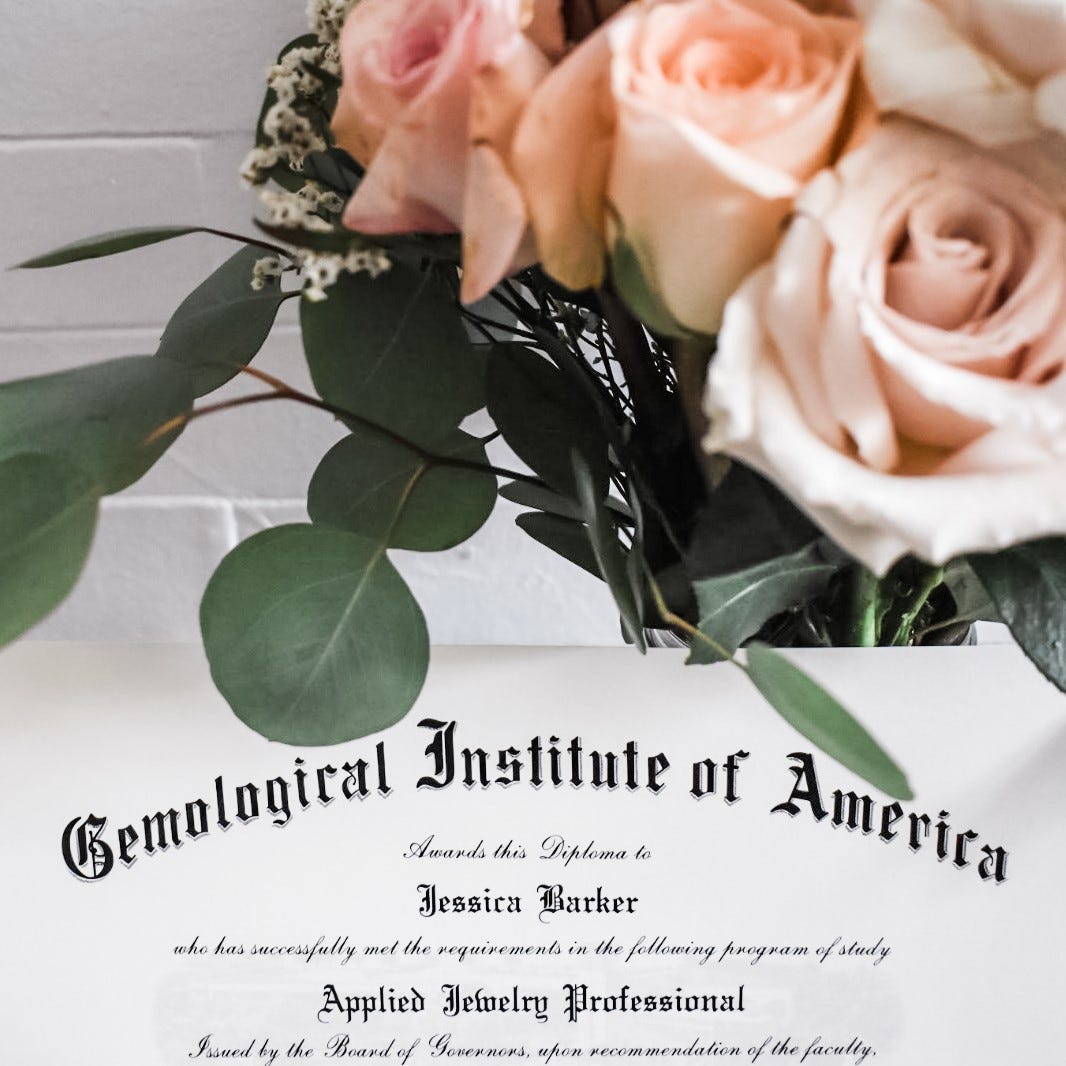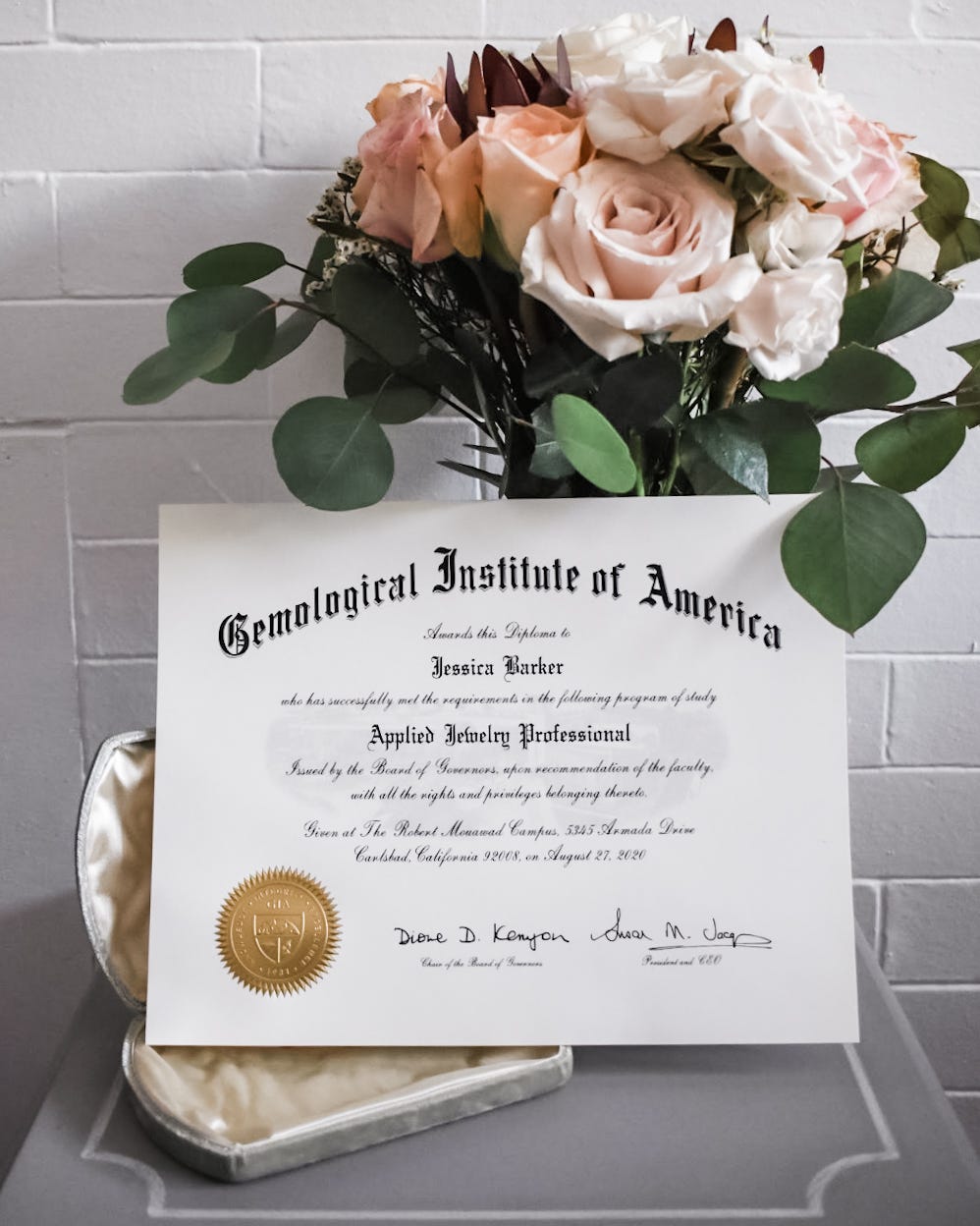GIA Applied Jewelry Professional Program Review
Curious about the AJP? I'm sharing my impressions after completing the GIA Applied Jewelry Professional diploma program.
This article was originally published on a WordPress blog that I’ve retired in favor of Substack. Thanks for reading!
Earlier in August this year, I completed the GIA Applied Jewelry Professional diploma program! While working through the course, I received a handful of questions about the GIA AJP program from others interested in enrolling. When I signed up, I wasn’t entirely sure what to expect, but I’ve been happy with the program overall. Here I’m sharing my own experiences in the hope that this resource will help you decide whether the GIA AJP program could be right for you!
What does GIA AJP stand for?
GIA stands for the Gemological Institute of America. “Established in 1931, GIA is the world’s foremost authority on diamonds, colored stones, and pearls. A public benefit, nonprofit institute, GIA is the leading source of knowledge, standards, and education in gems and jewelry.”
AJP stands for Applied Jewelry Professional, a designation earned by people who complete the Applied Jewelry Professional diploma program through the GIA.
It’s important to note that the AJP title is not the same as the GG or Graduate Gemologist designation. People who become Graduate Gemologists complete a lot more courses through the GIA and take an in-depth dive into the subject of gemology.

What do you learn during the AJP diploma program?
The GIA AJP program description covers the gist of what you’ll learn throughout your studies:
The Applied Jewelry Professional diploma program covers topics including jewelry designs, setting styles, jewelry care, and other content that will support the product knowledge of current industry professionals. The AJP program also introduces basic information about diamonds, rubies, emeralds, sapphires, and the GIA clarity grading system. Other subjects of study include how modern technology is changing the way diamonds are cut, the qualities of precious metals, major jewelry manufacturing methods, and the important activities involved in the operation of a retail jewelry store. To enable effective product conversations, examples are provided on how to translate jewelry features into benefits and how to communicate the 4Cs of diamond value to customers. The AJP program provides clear and concise information that can be immediately implemented on the job.
Additionally, here’s how the organization describes the main learning outcomes and what you’ll be able to do with the knowledge gained during your AJP studies:
Describe how the 4Cs (color, clarity, cut, and carat weight) affect a diamond’s value.
Recognize the relationship between size and weight of diamonds.
Explain the differences between treated, laboratory-grown, and imitation stones to sell with full disclosure.
Understand the steps of the jewelry sales process.
Translate jewelry design, style, and manufacturing features into benefits.
Convey the romance, lore, and characteristics of the most popular colored gemstones.
Why choose the AJP program?
After starting the Nine Golden Rings blog, I was eager to learn as much as possible about gems and jewelry. But I wanted to more than flip through books and sift around for answers to my questions. The AJP program seemed like a great fit for my needs. Additionally, my master’s degree was in fashion history, so I was familiar with the design history aspect of jewelry. This diploma program felt like a perfect next step to expand my knowledge.
Here are some advantages to the AJP program that make it appealing to me:
The courses are self-directed, meaning it’s possible to study at your own pace.
The information is presented in an organized, structured way allowing you to steadily build expertise.
The AJP program is offered in a 100% online format, making it easy to study from home.
The GIA is a well-known authority and the AJP is widely recognized in the industry.
The courses can be completed in a relatively short timeframe.
After completing the AJP program, you’ll earn a professional diploma and the AJP title, demonstrating your commitment to the field.
What courses are required as part of the AJP program?
The Applied Jewelry Professional program is made up of three “essentials” courses: Jewelry Essentials, Colored Stone Essentials, and Diamond Essentials.
Jewelry Essentials
As outlined by the GIA, here’s what the Jewelry Essentials course is all about:
This course examines jewelry’s important features and how they combine to give a piece its unique value. Content includes the unique qualities of precious metals, how to describe them to customers, and how to identify jewelry types and styles, using industry terms to describe them. Coursework also includes an examination of the different jewelry manufacturing methods, and how they can affect style, appearance, and durability. Other topics include how precious metals are regulated, marketed, and tested, and the key components of a compelling product presentation. The course also covers watches and giftware.
Colored Stone Essentials
Next up, here is the GIA’s summary of the Colored Stone Essentials course:
This course provides basic, essential knowledge of colored stones, with an in-depth focus on the ‘Big Three’ of the gemstone world: ruby, sapphire, and emerald. Subjects covered include the language of colored stones; color’s powerful role in gemstone value and the unique characteristics of popular colored stones; and how color, clarity, cut, and carat weight affect a gem’s value.
Diamond Essentials
Finally, here’s the GIA’s official description of the Diamond Essentials course:
This course covers how to describe diamond jewelry accurately for effective and ethical sales conversations with customers. Key topics examined include the internationally accepted GIA clarity grading system, how diamonds are graded for color, and how color affects value. Coursework includes how modern technology is changing the way diamonds are cut, the relationship between size and weight, and how retail jewelry stores operate.
Which course comes first second, and third?
You can technically complete these courses in any order. If you want, you can even work through them concurrently. But here’s the sequence I followed:
Jewelry Essentials
Colored Stone Essentials
Diamond Essentials
I would highly recommend taking the AJP courses in that order. The advantage is that you’re working from the most general topics to the most specific. Along the way, you’ll explore jewelry vocab, gemological concepts, and industry insights that you can draw upon during later lessons.
For example, you’ll learn about the anatomy of a ring and the qualities of different metals in Jewelry Essentials. Next, you’ll explore the Mohs scale of mineral hardness during Colored Stone Essentials. Finally, once you get to Diamond Essentials, you’ll be able to focus on the unique characteristics of diamonds themselves, since you’ve got that other important knowledge in your back pocket. When you run into the fact that a loose diamond can damage its prongs, you’ll already know what that means and why that is based on your prior education.

What does the GIA AJP program cost?
Tuition for each course in the GIA AJP diploma program is currently $250. For all three courses, that adds up to $750.
Earlier this year, however, the GIA was offering the three AJP "essentials" courses for free. This initiative was a response to the impact of COVID-19 on the jewelry industry. I was lucky enough to be able to take advantage of this amazing offer.
What are the GIA AJP courses and lessons like?
This is one of the biggest questions I had before starting my GIA studies. It helps to have some idea of what the course format is and how long each lesson takes, so you can decide whether you have enough time in your schedule to fit the courses in.
If you’ve had any past experience with e-learning, the course format will feel very familiar. The courses are delivered in an online platform where you can access things like the syllabus, lessons, and quizzes from a sidebar.
Each course – Jewelry Essentials, Colored Stone Essentials, and Diamond Essentials – is comprised of between 6 to 8 lessons.
When you begin a new lesson – or “activity,” as they’re called in the platform – it will open up in a new window. The information is presented bit by bit through a series of slides you can advance through. These typically include a few paragraphs of text to read, but there are also interactive image carousels, short videos, vocabulary definitions, and main idea summaries. Each lesson had somewhere around 25 to 35 slides.
Unfortunately, since the classes are all online, you don't get to work with gemstones in person. But you do get to look at lots of pictures of incredible gems and jewelry! Not quite the same, but the images and videos do a nice job of illustrating the concepts.
What about the GIA textbooks?
Although the GIA AJP course material is offered online, each course also comes with a PDF textbook. You can technically purchase a hard copy if you’d like. I considered it at first, but as soon as I saw the way the information was presented in manageable, bite-sized chunks within the online portal, I knew that was all I needed.
Essentially, each chapter in the textbook is a separate lesson in the online portal. And each chapter section is presented on a different slide. So, you’re essentially learning the same information in the same order as you would if you read the textbook cover to cover. But the interactive e-learning portal makes it so much more engaging. It doesn’t really feel like you’re reading a textbook when there are videos, images, and other resources mixed in.
How long does it take to complete each course and lesson?
You'll have three months to finish each "essentials" course once you enroll. I believe you can sign up at any time, and you'll be able to choose when you want to begin the course. But the official start date will be a Monday, and there are a few agreements you'll need to sign in advance. Once you've begun, you can access the course content 24/7 until the three-month period ends. The GIA will send you reminder emails about your progress and how much time you have left, too.
As for the individual lessons, I’m a fairly quick learner, but I did spend time taking notes to capture the most important concepts and vocab words. At that pace, it usually took me about two hours to complete a lesson. Of course, everyone will study at their own pace, but I would definitely say it’s realistic to fit in one lesson on a typical weeknight. With more intensive study it's also possible to tackle a couple of lessons over a weekend. Although I preferred to take them once at a time.
What are the GIA AJP quizzes and final exams like?
At the end of each lesson, you’ll complete a 15-question, multiple-choice quiz related to the content you just covered. I found these to be very easy and they only took a couple of minutes to complete. They’re open-book, too, meaning you can refer to your notes or the PDF textbook to make sure you have the correct answer before submitting the quiz.
Once you finish a quiz, you can go back and see what questions you got right and wrong. You’ll earn a pass/fail grade, and you’ll have the chance to go back and retry the quiz until you pass.
At the end of each course, you’ll complete a 50-question, multiple-choice exam. It will be in the same format as the quizzes, but you’ll be tested on information from the entire course.
So, with the GIA Jewelry Essentials final exam, you could be asked about anything you learned from lesson 1 to the end of the course. However, you won’t be quizzed on any content from another course like Diamond Essentials. Additionally, there is not a cumulative AJP final exam; once you complete all three courses successfully, you’ll have earned your AJP diploma!
You will have 3 attempts to retry each final exam and you must get at least 75% of the answers correct in order to pass. But since the final exams are also open book, you should have no problem passing if you make sure to check your work.
Was anything surprising about the course content?
I think the course descriptions do a great job of outlining what the lessons actually cover. So, I won’t dwell too much on that. If the course descriptions seem in line with your interests, the GIA Applied Jewelry Professional program could be a great choice! But I will share some of my other impressions on how the courses surprised me.
Unexpected sales training emphasis
I wasn’t expecting there to be such a prominent emphasis on jewelry sales and the all-important sales presentation. I suppose this makes sense if the target student is someone working for a jewelry store. But I wasn’t necessarily anticipating video explanations on how to respond to a smash-and-grab. At times, I almost wished the retail sales training content was moved into its own separate course since it didn’t really align with my interests.
However, the plus side of this is that I was introduced to some important practical skills, like how to properly pick up gemstones with tweezers. And, now that I’m selling jewelry on Etsy, some of the tips are coming in handy after all!
Some slightly dated course content
One thing I found a bit disappointing about the GIA AJP program curriculum was the fact that some of the material is pretty dated. Many of the videos are clearly from the early 2000s, meaning the industry insights and sales strategies aren’t as relevant as they could be. Online jewelry shopping is still considered a new trend, and social media doesn’t even earn a mention. But the fact that I see people casually sell $20,000 diamond necklaces on Instagram makes me believe these sales channels are incredibly important facets of the industry. It would be great to see the course content updated to reflect these new ways of doing business.
Additionally, the courses reference outdated FTC Jewelry Guides (which I talk more about here). These were updated in 2018, so I would have loved to see the new guidance cited throughout the course.
Neither of these factors significantly decreased the value of the courses, in my experience. As I mentioned, the AJP program really does cover a lot of ground and hits on all the topics advertised in the course descriptions. But the sales emphasis and slightly dated resources might be worth considering, especially if you’re looking at paying full tuition.
Who is the GIA Applied Jewelry Professional program really for?
Of course, anyone who meets the organization’s enrollment criteria can participate in the GIA AJP diploma program. And anyone with an interest in gems and jewelry will surely love it!
However, the course is intentionally directed at someone pursuing a traditional jewelry retail sales career. I think it would also be valuable for an online jewelry seller as well. An ardent collector who wants to learn more about the gems they’re encountering might also find value in the course, although I wouldn’t expect the average consumer to enjoy it.
After earning the GIA AJP diploma, I’m confident that I have a solid, working foundation of jewelry and gemology knowledge. At the same time, I also feel confident knowing what additional questions to ask and what information I don’t necessarily know at this point. For instance, I now know that differentiating a lab-created gem from an earth-mined stone isn’t as easy as people often think it is!
Final thoughts
Overall, I’m thrilled I had the chance to complete all three “essentials” courses and earn my GIA Applied Jewelry Professional diploma this year. It’s definitely been one of the highlights of 2020. Stay tuned to find out where my newfound knowledge takes me!







